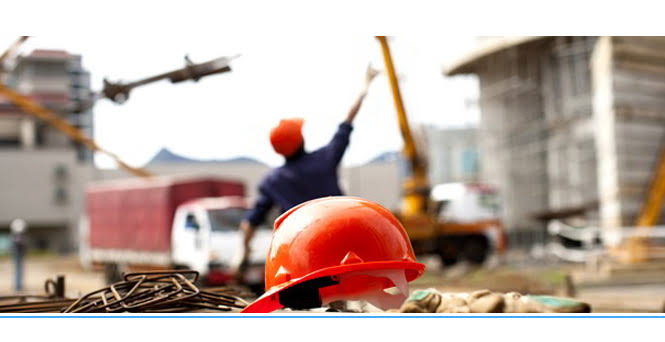Home > Fire Erection All Risk Policy
Erection All Risk Policy
Covers losses during machinery or equipment installation, providing vital financial protection for construction and manufacturing industries against various risks.
What is Erection All Risk Policy?
An erection all risk (EAR) policy is an insurance plan that protects you when
you’re setting up machinery or equipment in a factory or office.It covers any losses or damages that happen during the installation process.If anything goes wrong, this policy helps you financially, which could slow down
the installation and increase costs.The coverage of an EAR insurance policy starts from the moment materials are
unloaded at the construction site and continues until the project is finished and
handed over to the client.

Features of Erection All Risk Policy
It offers comprehensive insurance for the erection of projects and provides cover during storage, erection, and testing of heavy plant & machinery at the insured site.
It provides coverage for the entire period of the project rather than on a yearly basis.
Customers can add various features as needed.
Who needs
Erection All Risk Policy?
Contractors and employers can take out the policy jointly and individually. Any of the
following parties involved in the construction process may be covered :
1. General contractors
2. Subcontractors
3. Suppliers and manufacturers of equipment
4. The purchaser or owner of the equipment
Why get Erection All Risk Policy?
If you're in the construction business, the erection all risk policy is really helpful.It's a complete insurance policy that protects you from things going wrong when
you're installing, testing, and starting up equipment or machinery during
construction. At Finvest India, we can give you a personalized price from the best
insurance companies at a price that won't break the bank.

Coverages & Exclusions in
in Erection All Risk Policy
Once the first delivery arrives at the project site, the insurance coverage called EAR
(Erection All Risks) starts. It lasts until the testing is finished or when the project is
handed over to the main employer, whichever happens first.
Here are some common things that are covered by this insurance.
Storms, Floods, Cyclones, Earthquakes, and Allied Perils
It protects losses or damages that occur because of these covered perils during the installation period. It includes damage to the construction site, materials, equipment, or structures resulting from storms, overflowing rivers, heavy rainfall, or other flood-related events, cyclonic events, tremors, other earthquake-related factors, and other related perils.
Third-party Liability
This add-on cover provides protection for legal liability related to accidental damage or loss to the property of a third person, arising out of the erection work of the insured. It also covers the legal liability for non-fatal and fatal injuries caused to a third person due to the work.
Fire, Explosion, Lightning, and Aircraft Damage
This cover refers to the protection provided for losses or damages that occur as a result of these specific perils during the construction or installation period. It includes damage to the construction site, materials, equipment, and structures due to fire-related incidents and explosions. This may be caused by factors such as gas leaks and chemical reactions, damage due to lightning-induced fires, electrical surges, and incidents where aircraft collide with the construction site, equipment, or structures, causing damage or destruction.
Negligence and Human Errors
EAR insurance policies often include coverage for loss originating from negligence and errors in the design, planning, or supervision of the erection work. An EAR insurance policy may also cover liability claims in cases of negligence or human error resulting in third-party injuries or property damage. This includes legal defense costs and any settlements or judgments against the insured party due to their negligence or errors.
Burglary and Theft
This coverage addresses the risk of theft or burglary-related incidents that may occur at the construction site or involve the insured property. It applies to theft incidents involving construction materials, equipment, tools, machinery, or other valuable items related to the project. It also provides coverage for losses or damages resulting from burglaries, which involve unauthorized entry or forced entry into locked premises or storage areas.
Faults in the Erection of a Building
This policy covers damage to the construction site, materials, equipment, or structures caused by riots, demonstrations, protests, or other forms of public disturbance. It also includes damage resulting from strikes, lockouts, labor disputes, or other related events that may affect the construction project.
Riot & Strike
This coverage covers damage to the construction site, materials, equipment, or structures caused by riots, demonstrations, protests, or other forms of public disturbance. It also includes damage resulting from strikes, lockouts, labor disputes, or other related events that may affect the construction project.
Storms, Floods, Cyclones, Earthquakes, and Allied Perils
It protects losses or damages that occur because of these covered perils during the installation period. It includes damage to the construction site, materials, equipment, or structures resulting from storms, overflowing rivers, heavy rainfall, or other flood-related events, cyclonic events, tremors, other earthquake-related factors, and other related perils.
Third-party Liability
This add-on cover provides protection for legal liability related to accidental damage or loss to the property of a third person, arising out of the erection work of the insured. It also covers the legal liability for non-fatal and fatal injuries caused to a third person due to the work.
Fire, Explosion, Lightning, and Aircraft Damage
This cover refers to the protection provided for losses or damages that occur as a result of these specific perils during the construction or installation period. It includes damage to the construction site, materials, equipment, and structures due to fire-related incidents and explosions. This may be caused by factors such as gas leaks and chemical reactions, damage due to lightning-induced fires, electrical surges, and incidents where aircraft collide with the construction site, equipment, or structures, causing damage or destruction.
Negligence and Human Errors
EAR insurance policies often include coverage for loss originating from negligence and errors in the design, planning, or supervision of the erection work. An EAR insurance policy may also cover liability claims in cases of negligence or human error resulting in third-party injuries or property damage. This includes legal defense costs and any settlements or judgments against the insured party due to their negligence or errors.
Burglary and Theft
This coverage addresses the risk of theft or burglary-related incidents that may occur at the construction site or involve the insured property. It applies to theft incidents involving construction materials, equipment, tools, machinery, or other valuable items related to the project. It also provides coverage for losses or damages resulting from burglaries, which involve unauthorized entry or forced entry into locked premises or storage areas.
Faults in the Erection of a Building
This policy covers damage to the construction site, materials, equipment, or structures caused by riots, demonstrations, protests, or other forms of public disturbance. It also includes damage resulting from strikes, lockouts, labor disputes, or other related events that may affect the construction project.
Riot & Strike
This coverage covers damage to the construction site, materials, equipment, or structures caused by riots, demonstrations, protests, or other forms of public disturbance. It also includes damage resulting from strikes, lockouts, labor disputes, or other related events that may affect the construction project.
While the Erection All Risk Policy offers extensive coverage, there are certain situations
that are typically not included in most Erection All Risk policies.
1. Loss or damage due to a wilful act or wilful negligence
2. Cessation of work
3. Manufacturing defects
4. Consequential loss
5. Inventory losses
6. Loss or damage due to nuclear reaction, nuclear radiation, or radioactive contamination
7. Loss or damage due to war or warlike operations
8. Losses due to normal wear and tear, gradual deterioration
1. Loss or damage due to a wilful act or wilful negligence
2. Cessation of work
3. Manufacturing defects
4. Consequential loss
5. Inventory losses
6. Loss or damage due to nuclear reaction, nuclear radiation, or radioactive contamination
7. Loss or damage due to war or warlike operations
8. Losses due to normal wear and tear, gradual deterioration
About Erection All Risk Policy
What is the difference between CAR and EAR Policies?
a. CAR coverage typically protects constructions or contractors from all risks
and is mostly utilized for the movement of debris and concrete building
activity.
b. CAR is better suited for civil construction projects such as buildings, bridges, roads, and ports.
c. On the other hand, EAR coverage is taken while installing machinery and equipment. EAR is more suited to engineering facilities and other construction projects that include erections and installations.
d. EAR insurance policies, for example, cover the development of power plants, gas processing facilities, and other facilities.
b. CAR is better suited for civil construction projects such as buildings, bridges, roads, and ports.
c. On the other hand, EAR coverage is taken while installing machinery and equipment. EAR is more suited to engineering facilities and other construction projects that include erections and installations.
d. EAR insurance policies, for example, cover the development of power plants, gas processing facilities, and other facilities.
Who can take the EAR Policy?
The policy can be purchased jointly by the contractor and the employer. All
parties involved in any type of construction may be covered by insurance:
a. Contractors in general
b. Subcontractors
c. Equipment suppliers and manufacturers
d. Purchaser or proprietor
a. Contractors in general
b. Subcontractors
c. Equipment suppliers and manufacturers
d. Purchaser or proprietor
What is the extended maintenance period in the EAR policy?
a. The extended maintenance period is an additional duration of coverage
provided under an EAR policy.
b. It begins immediately after the scheduled completion of the construction and continues for a specified period, typically ranging from several months to a year.
c. This is a period in which the insured contractor complies with its obligations to complete outstanding work and remedy defects as per the provisions of the contract.
b. It begins immediately after the scheduled completion of the construction and continues for a specified period, typically ranging from several months to a year.
c. This is a period in which the insured contractor complies with its obligations to complete outstanding work and remedy defects as per the provisions of the contract.
Is the erection all risk policy compulsory?
a. In India, there is no specific law or regulation that mandates contractors to
have an erection all risk policy (EAR insurance) policy.
b. However, taking out an EAR policy is a good idea if you are involved in any construction or erection project.
c. This is because there are many risks involved in these types of projects, and an EAR policy can help to protect you financially in the event of a loss.
d. It is a small investment that can provide you with peace of mind, along with financial protection in the event of a loss.
b. However, taking out an EAR policy is a good idea if you are involved in any construction or erection project.
c. This is because there are many risks involved in these types of projects, and an EAR policy can help to protect you financially in the event of a loss.
d. It is a small investment that can provide you with peace of mind, along with financial protection in the event of a loss.
Is there any specific time limit set for submitting claims under the erection all policy?
a. Yes, each insurer has set up a deadline for submitting claim
documentation.
b. So, it is usually advisable to submit the documents as soon as they become available.
c. The sooner you submit all the necessary paperwork, the sooner you will receive your claim.
b. So, it is usually advisable to submit the documents as soon as they become available.
c. The sooner you submit all the necessary paperwork, the sooner you will receive your claim.
What are the documents required for filing a claim under the erection all risk policy?
Here are some common documents that are typically required while filing an EAR
claim:
a. Detailed RFQ (Request for Quotation)
b. Details related to the principal, contractor, sub-contractor
c. Estimated cost of the project
d. Projects start date and end date, including the bar chart
e. Details related to testing for EAR projects
f. Equipment details for EAR projects
g. Sum Insured breakup towards the different scope of works
h. Risk location details i. In case of multiple locations- the names and coordinates of all locations
j. Complete/detailed scope of works or contract copy
k. Wet work details, if involved
a. Detailed RFQ (Request for Quotation)
b. Details related to the principal, contractor, sub-contractor
c. Estimated cost of the project
d. Projects start date and end date, including the bar chart
e. Details related to testing for EAR projects
f. Equipment details for EAR projects
g. Sum Insured breakup towards the different scope of works
h. Risk location details i. In case of multiple locations- the names and coordinates of all locations
j. Complete/detailed scope of works or contract copy
k. Wet work details, if involved
Who can be insured under the EAR Policy?
a. Both contractors, as well as employers, can be insured in this policy either
individually or in joint names.
b. Several parties that can be insured under this policy include general contractors, subcontractors, equipment suppliers& manufacturers, and also the buyer or the owner.
b. Several parties that can be insured under this policy include general contractors, subcontractors, equipment suppliers& manufacturers, and also the buyer or the owner.
How is the premium computed for the erection all risk policy?
a. An insurance company examines several aspects while calculating risks
and quoting the premium for the erection all risk insurance policy.
b. These criteria include the scope, location, cost, and time frame for the construction work
b. These criteria include the scope, location, cost, and time frame for the construction work
Can the erection all risks insurance policy covers financial losses caused by delays in the completion of the project?
Yes. Most erection all risk policies provide coverage for financial losses during
the erection process, including delays in the construction schedule.
What do AOG perils mean?
a. In insurance, 'Act of God' (AOG) is a term used to describe perils or
events that are beyond human control and are not caused by human
action or negligence.
b. These perils are typically covered under insurance policies to provide protection against losses.
c. Acts of God's perils can include a wide range of events, such as earthquakes, hurricanes, floods, lightning strikes, volcanic eruptions, tsunamis, fires caused by natural factors, and other catastrophic events.
b. These perils are typically covered under insurance policies to provide protection against losses.
c. Acts of God's perils can include a wide range of events, such as earthquakes, hurricanes, floods, lightning strikes, volcanic eruptions, tsunamis, fires caused by natural factors, and other catastrophic events.
How is the premium calculated for erection all risk?
Here is how premium is calculated:
Sum Insured – The higher the sum insured, the higher the premium; and vice versa.
Project Duration – A longer installation period will result in a higher premium.
Type of Project – Projects with higher risks, such as large-scale infrastructure developments or projects involving environmental and location risk, may attract higher premium
Testing Period – As soon as the new machinery is installed, it is tested before being handed over to its owners. This period is used to calculate the premium.
Insured seek voluntary access – A voluntary excess option, if availed as part of the policy, may result in a reduction in premiums.
Sum Insured – The higher the sum insured, the higher the premium; and vice versa.
Project Duration – A longer installation period will result in a higher premium.
Type of Project – Projects with higher risks, such as large-scale infrastructure developments or projects involving environmental and location risk, may attract higher premium
Testing Period – As soon as the new machinery is installed, it is tested before being handed over to its owners. This period is used to calculate the premium.
Insured seek voluntary access – A voluntary excess option, if availed as part of the policy, may result in a reduction in premiums.
What is the claim procedure of EAR policy?
The insured shall –
a. Inform the broker, his will handhold and guide youth rough out the claim
settlement process.
b. Notify the police in case of theft or burglary losses or damages at the construction site
c. Cooperate with the surveyor of the company to make him inspect the affected parts.
d. Provide all information and documentation as requested by the company.
b. Notify the police in case of theft or burglary losses or damages at the construction site
c. Cooperate with the surveyor of the company to make him inspect the affected parts.
d. Provide all information and documentation as requested by the company.


